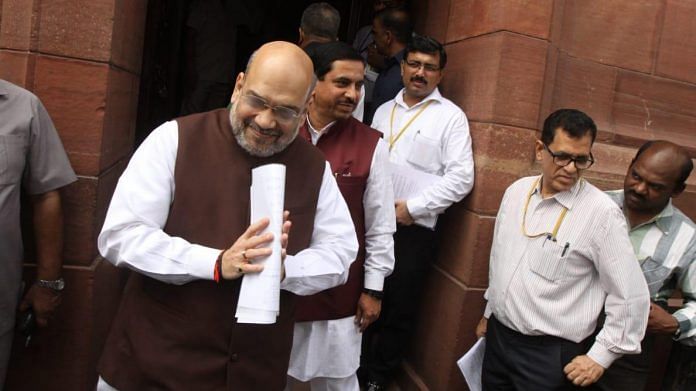The Jammu & Kashmir Reorganisation Bill, 2019 seeks to bifurcate J&K into two Union Territories – J&K with a legislature and Ladakh without a legislature. The Bill was introduced in Parliament following the issuance of the Constitution (Application to Jammu and Kashmir) Order, 2019 by the President under Article 370(1) of the Constitution.
I confine myself to the legal issues entailed by the Bill. I have long maintained that the genesis of the Kashmir issue or its resolution is not located in Article 370.
It is well-settled that the Constitution does not guarantee the territorial integrity of the constituent states of the Indian Union. Nor is there a constitutional guarantee that a constituent state of the Indian Union, which was existing at the commencement of the Constitution, must continue to exist.
Also read: After Article 370, Modi’s first test in Kashmir will begin once curfew is lifted
Constitutional relationship of J&K with Union
Article 3 of the Constitution provides that Parliament may by law form a new state and alter the areas, boundaries or names of any state. The proviso to Article 3, however, inter alia provides that no Bill for such purpose will be introduced in Parliament unless it has been referred by the President to the state legislature for expressing its views on the same.
The only exception to this, so far, was the J&K state. Article 370 applies Article 1 to J&K thereby recognising it as a constituent state within the Indian Union.
The constitutional relationship of J&K with the Indian Union was, however, contemplated to be that of an autonomous republic within the Indian Union. This was crystallised in the Delhi Agreement, 1952, which was ratified by both Parliament and the state Constituent Assembly.
The President, with the concurrence of the J&K government, then issued the Constitution (Application to Jammu & Kashmir) Order, 1954 under Article 370(1). This order inserted into the Constitution the provisions to give effect to the Delhi Agreement, 1952 and also applied further Articles of the Constitution to J&K (with modifications). These included Article 3 of the Constitution with an additional proviso that mandated that ‘no Bill providing for increasing or diminishing the area of the State of Jammu and Kashmir or altering the name or boundary of that State shall be introduced in Parliament without the consent of the Legislature of that State.’
In other words, not only did J&K not merge its territory with the Indian Union, but it explicitly preserved its territorial integrity as also identity.
Also read: No debate, no discussion, no dissent, and the Constitution is changed
What the 2019 Order says
The 2019 Order supersedes the 1954 Order and applies all the provisions of the Constitution to J&K. The validity of the 2019 Order is debatable. Be that as it may, it is in force unless and until it is struck down. Hence, the position that emerges is that by virtue of Article 3 of the Constitution, Parliament may by law alter the areas, boundaries and name of J&K without the consent of the state legislature. However, under the proviso to Article 3, it is necessary that the Jammu & Kashmir Reorganisation Bill, 2019 be referred to the state legislature for its views.
But then, with J&K currently under President’s rule, there is no state legislature that can express its views on the Bill. And, as all the provisions of the Constitution have been made applicable to J&K by the 2019 Order, Parliament can exercise the functions of the state legislature during President’s rule by virtue of Article 356 of the Constitution. The real question is: should Parliament do so.
Now, Article 356 is not meant to take far-reaching decisions but is an emergency provision to be resorted to sparingly in a situation where there is breakdown of constitutional machinery in a state. The exercise of power under Article 356 is limited by time as provided in Article 356 itself. It is a temporary arrangement until the government of the state is re-elected in accordance with the Constitution.
What Supreme Court says
While the Constitution does not guarantee territorial integrity of a state, the Supreme Court has held that Constitution is federal or at least quasi-federal in nature. The 13-judge Bench’s decision in Kesavananda Bharati (1973) has gone to the extent of viewing the federal character of the Constitution as part of its basic structure.
Would it then be justifiable for Parliament to exercise the function of the state legislature (while the state is under President’s rule) in matters that dismember the state as also its identity?
The obvious answer is no, both in view of the scope of Article 356 as well as the principle of federalism enshrined in the Constitution. Should the Jammu & Kashmir Reorganisation Bill become a law in the current circumstances, it may be open to legal challenge for these reasons alone.
Also read: The constitutional questions that arise from the end of Jammu and Kashmir as a state
The author is Advocate, Supreme Court of India and Author of Unravelling the Kashmir Knot. Views are personal.




waste of time.
What is the point you are trying to make ?
What is the outcome you are trying to drive to?
There have always been traitors. How else could invaders destroy and colonize us for so long. This traitor belongs to the same category.